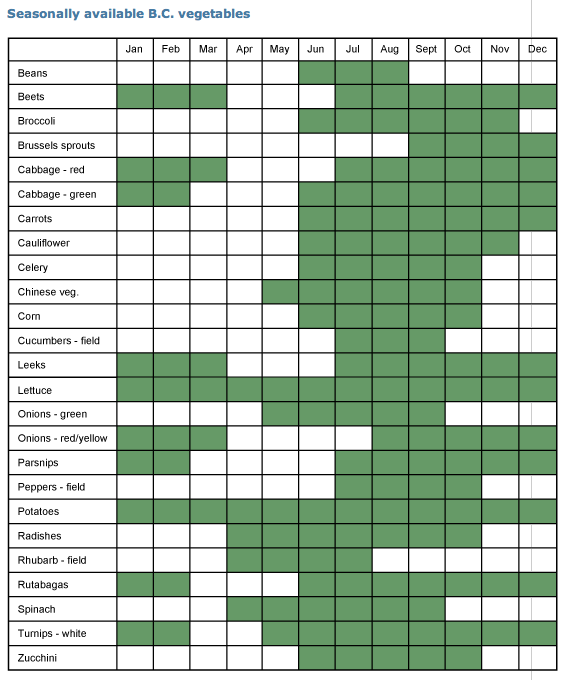My next meal of the day was a salad for lunch. My salad consisted of spinach, red peppers, cucumbers, carrots, beets and chickpeas. Since this meal was mostly produce, it is good idea to look at where these products are grown and whether they are in season this time of year.These are two major factors that influence the “ecological footprint” of anyone’s diet as large transportation costs greatly increase the amount of oil that goes into getting the fruits or vegetables from the farm to the table. Here is a chart that I found that shows seasonal produce in B.C. (source: http://www.actnowbc.ca/everyone/buy_local,_in_season_fruits_and_vegetables)
So, out of my salad, the only vegetable that was actually in season was beets. This is shocking to me, probably because grocery stores continually stock their shelves with most vegetables year- round, even if they have to come from thousands of miles away.
An interesting concept that I came across is that of “food miles“, a term developed by Professor Tim Lang in the 1990’s. It is a way of quantifying the effect that food transport and production has on the environment. While roughly 83% of carbon emissions from food production are associated with processing and packaging, about 12 % are associated with transport and delivery (Source: http://en.wikipedia.org/wiki/Food_miles). In the sound clip below, Tim Lang discusses how to make our food system more sustainable. He asserts that while consumers have some choice in the the products they buy, the government also has a role in regulating and developing a sustainable food system:
Tim Lang on How to Solve the Food Crisis
Overall, although it is generally more environmentally-friendly to purchase unprocessed foods with as little packaging as possible, it is important to remember what foods are available seasonally and locally. This is the basis for many current trends such as the 100-mile diet or the low- carbon diet or the locavore diet. So while my salad lunch was good in terms of little oil use in terms of packaging and processing, many of the out-of-season vegetables I used were likely from places thousands of miles away. This greatly increases the food miles involved with this meal. The chart above, displaying the seasonal prouduce in B.C. is something I will refer to in the future in attempt to reduce the carbon footprint of my meals.
Tags: No Comments



0 responses so far ↓
There are no comments yet...Kick things off by filling out the form below.